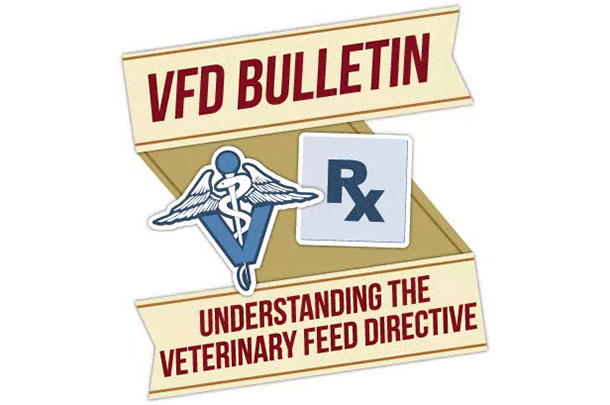A few months ago, my veterinarian, “Doc,” wouldn’t give me a Veterinary Feed Directive (VFD) for medicated  mineral to prevent anaplasmosis in our cow herd because the mineral label and the VFD form both clearly state: “For the control of active infection of anaplasmosis caused by Anaplasma marginale susceptible to chlortetracycline.”
mineral to prevent anaplasmosis in our cow herd because the mineral label and the VFD form both clearly state: “For the control of active infection of anaplasmosis caused by Anaplasma marginale susceptible to chlortetracycline.”
To be fair, we’ve never had a confirmed case of anaplasmosis in our herd, and Doc spent an amazing amount of his time (which is usually in short supply) explaining the rules of the VFD and rationale behind it, as well as how anaplasmosis is transmitted, and I came to appreciate where he was coming from.
It’s safe to assume veterinarians across the country are spending time educating clients about the VFD. Let’s test your knowledge with a true-or-false quiz:
Legally, you can feed a mineral containing chlortetracycline (CTC) to prevent pinkeye as long as you have a VFD.
Legally, you can feed a mineral containing CTC to prevent anaplasmosis, as long as you have the corresponding VFD.
Legally, you can hand-feed the CTC crumbles you have left over from before the new VFD rule, even if you don’t have a VFD for those.
Legally, you can hand-feed a mineral containing CTC to treat an active infection of hoof rot as long as you have a VFD from your veterinarian.
If you answered yes to any of these, you need to brush up on the Veterinary Feed Directive. VFD drugs are those antibiotics medically important in humans which can be used in animal feed but only with a licensed veterinarian’s supervision and a valid veterinarian-client-patient relationship.
Dee Griffin, DVM, professor of animal science, West Texas A&M University says, “You have to have a veterinarian-client-patient relationship. Veterinarians are going to do that at the level they are comfortable with. So if they work with you all the time, and have for years, they’re going to work with you within the VFD rule.
Some veterinarians will be less comfortable with that and will feel like they have to have a farm visit to not violate federal law, even in instances where they have an ongoing relationship with the producer.”
Griffin says, “Producers don’t get the form that goes to the retail business selling the medicated product. It is the veterinarian’s responsibility to deliver the VFD to the approved facility providing the medicated product, within a relatively short period of time, 24 hours later.”
Michael Apley, DVM, Frick professor of clinical sciences at Kansas State University College of Veterinary Medicine, says, “A veterinarian cannot legally authorize, and a producer cannot legally use, CTC in the feed for treatment or control of pinkeye or foot rot.
This has been the case for at least two decades. Now the veterinarian is just officially in the loop and, for in-feed uses, may only legally authorize exactly what is on the label.”
But what about anaplasmosis? Can’t we fudge a little on the rules? Jeremy Powell, DVM, professor of animal science, University of Arkansas, says, “The devil is always in the details, and the label for CTC (which must be followed to the letter) indicates it can be fed for ‘control of active infection of anaplasmosis.’ Therefore, it would be very important for the disease to have been diagnosed by the attending veterinarian for them to be writing the VFD for control of anaplasmosis.”
Griffin says, “I know about anaplasmosis in Oklahoma. They’re going to have dead cows. Now, I don’t mean an outbreak where hundreds of cows are dead, but if you own a hundred cows, and your neighbors own a hundred cows on four sides of you, one of you is going to have a dead cow in the summer.”
This seems to be the biggest concern cow-calf producers have with the VFD rules. But Julie Leonard, VitaFerm dealer in northwest Arkansas says, “Most of my clients use a mineral with IGR (insect-growth regulator) and say a prayer.”
Mark Rubes is owner of Six Mile Creek Cattle Company in Yukon, Oklahoma, and runs about 100 head of registered Hereford cows. He has neighbors with cows, and they’ve had a veterinarian-confirmed problem with anaplasmosis in recent years. He says, “The vets and vendors were really good about having the scripts set up along with software to make the process pretty easy.”
Dadgum that new VFD. But wait, the VFD isn’t exactly new – in fact it’s older than I am; they’ve just tightened it up a bit because of concerns over antibiotic resistance.
In 1966, the Animal Drug Availability Act (ADAA) (H.R. 2508) became law, amending the Federal Food, Drug and Cosmetic Act to allow more flexibility in the way the FDA regulates new drugs and medicated feeds for animals. Recently, the FDA amended the VFD regulations, and the final rule became effective Jan. 1, 2017.
The law was originally intended to increase the number of new, approved animal drugs on the market and had the support of the FDA’s Center for Veterinary Medicine as well as strong support from industry groups such as veterinarians, animal health product manufacturers and even livestock producers.
According to the FDA’s website, “ADAA made changes that were intended to benefit the animal health industry and the nation’s animals without compromising FDA’s mission to protect the public health.” The provisions of the original ADAA include:
- An amended definition of “substantial evidence of effectiveness,” making approval process for new drugs more flexible.
- More interaction between animal drug manufacturers and the FDA during development.
- Procedure for establishing import tolerances for residues of animal drugs not approved in the U.S. but legal in other countries and present imported animal-derived food and food products.
- Allowing a range of doses on new animal drug labels rather than a single optimum dose.
- Provides direction to the FDA on how to review supplements to an approved application.
- Created a new category of drugs, “Veterinary Feed Directive drugs,” that allows the approval and use of new animal drugs in animal feed on a veterinarian’s order.
Educating producers about the VFD is helpful, but there are others in the supply chain who need education. There have been instances where producers asked for medicated mineral with monensin at their feed store and were asked if they had a VFD. Monensin isn’t among the antibiotics regulated by the VFD and doesn’t require one.
Producers have been frustrated the VFD is like a prescription and has limitations. Griffin says, “There are some misconceptions among producers. Some producers would like to have that script handed to them and get it filled anywhere they want, whenever they want.
It has long been an FDA control that prescriptions can only be filled by one pharmacy, and they’ve carried that practice on in the animal side as well.” Using this analogy, it is reasonable the VFD can only be redeemed at one feed retailer as opposed to many.
Three things to remember:
- A VFD is effective for up to six months.
- Veterinarians, feed suppliers and producers must keep a copy of each VFD for two years.
- Extra-label use of medicated feed additives has not been and will not be allowed.
The VFD rule has been seamlessly implemented in the feedlot sector. Feedlots are equipped and prepared for the accountability and recordkeeping required under the VFD. Griffin says, “The companies that service the feedlot industry, and their drivers, know more about the VFD than veterinarians in certain areas of the country.
It’s all computerized, accounted for and inventoried to within 100 grams every 24 hours. Feedyards that use 100 kilos of antibiotics every day, the antibiotics are measured within a gram. They have very tight controls.”
In an environment of increasing regulation, Griffin says we can expect even more restrictions from the FDA. “Everything you think about being over-the-counter will not be over-the-counter by 2018. Penicillin, terramycin, neomycin – you’ll have to have a VFD.”
We don’t make the rules, we just follow them. That seems to be a new mantra in the beef cattle industry, and it’s best to be educated and prepared for the changes we face in the future. ![]()
PHOTO: The VFD has been more easily adopted in the feedlot sector because they are already equipped and prepared for the accountability and recordkeeping required under the rule. Staff photo.
Melissa Beck is a freelance writer based in Prescott, Arkansas. Email Melissa Beck.






